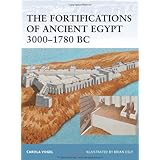
Average Reviews:

(More customer reviews)I have an intense interest in ancient Egypt, and a long standing, less intense one with military history. Osprey Publishing is noted for its many series of books on military matters. Each book treats a narrow topic in great depth, in a style accessible to the general reader. The author of The Fortifications of Ancient Egypt 3000-1780 BC is Egyptologist Dr. Carola Vogel who has specialized in Egyptian military forts of the Old and Middle Kingdoms. The 10 by 7 ¼ inch book has 64 pages. It is well illustrated in a large variety of ways: maps, photos in black and white and in color, diagrams, plans and cross-sections of structures, renderings by the artist (Brian Delf) of how the forts would have appeared, tomb paintings, and drawings of temple reliefs and of rock drawings. Nearly all illustrations are new to me, despite the existence of over 150 books on ancient Egypt in my library. My only quibble is that a small handful of the plans that come from scholarly sources are reproduced in such small scale that they are difficult to study. Some novel illustrations include a soldier getting a haircut, a soldier's bread ration token (wooden), and a game piece (?), two inches high, depicting a crenellated tower. The latter is accompanied by an artist's depiction, in a cut-away view, of the tower.
Some phrases from the Contents page may show the scope of the text: geographical features, chronology of fortification development, materials, defensive structures, gates, ditches, linear defenses, barracks, commander's residence, headquarters, treasuries, granaries, magazines, eating habits, hygiene, temples, private cult, make-up of the garrison, dispatches, storming the fortress, the sites today, further reading, glossary of Egyptological terms, technical terms, further reading, index.
Prior to buying this book, I was only acquainted with the famous mud brick fort of Buhen just north of the second cataract. (There is a large model of this fort in the Nubian Museum in Aswan.) The book treats in detail four forts and mentions over a dozen others. It lists the names (in hieroglyphics, with translation) of the 17 forts given in a papyrus called the Ramesseum Onomasticon together with possible identifications with known archaeological sites. Other hieroglyphic texts (with translations) include a stela from the Semna-west fort, and a rock inscription from Uronarti, both from the time of Senusret III. Other Ospry books include: Qadesh 1300 BC, Soldier of the Pharaoh, New Kingdom Egypt, and Bronze Age Chariots.
Click Here to see more reviews about: The Fortifications of Ancient Egypt 3000-1780 BC (Fortress)
During the Old and Middle Kingdoms, Ancient Egypt led the world in the construction of fortifications. The oldest was discovered on Elephantine Island and dates to c.2900 BC. This book investigates over 2,000 years of Egyptian fortification, including both fortified cities and military installations. It covers the most famous sites, including the fortified town of Ayn Asil and the fortress of Buhen. The text also examines the specific defensive structures within the fortifications, including gates, walls, and towers, and looks at both the operation and social history of these ancient military strongholds. Maps, photographs, and artwork by Brian Delf recreate this long-lost but legendary era, a treat for the eye as well as the mind.
Click here for more information about The Fortifications of Ancient Egypt 3000-1780 BC (Fortress)

0 comments:
Post a Comment